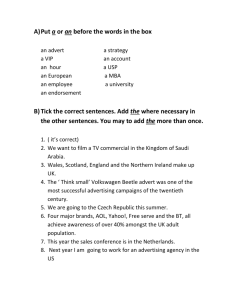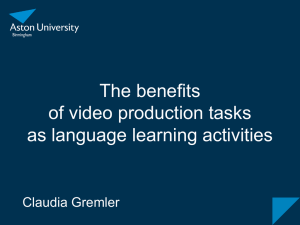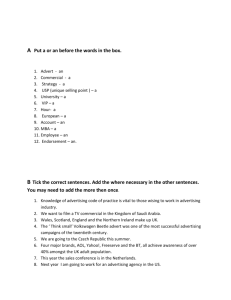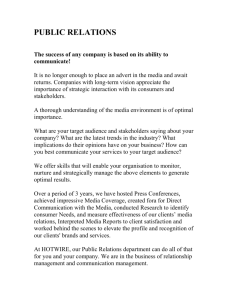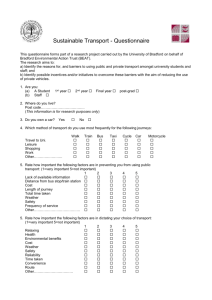Dr Claudia Gremler – Presentation
advertisement
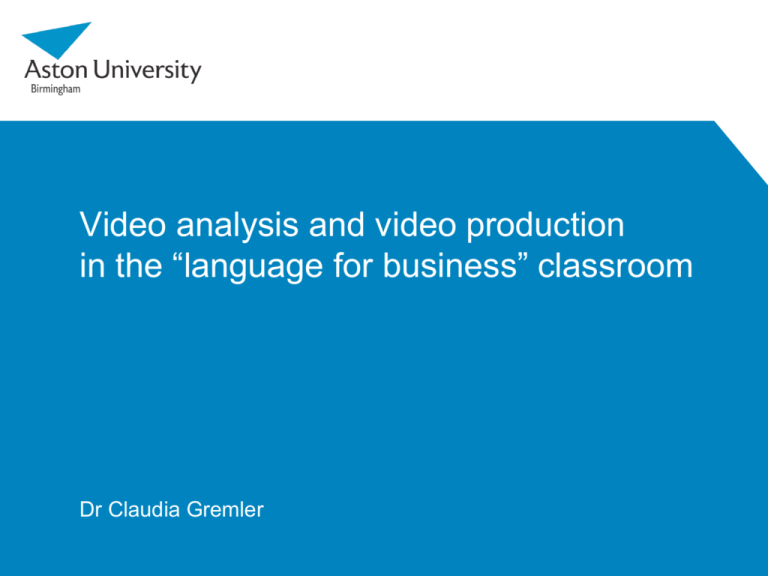
Video analysis and video production in the “language for business” classroom Dr Claudia Gremler Aston’s IBML degree programme BSc programme International Business and Modern Languages (IBML) (since 1985) Taught jointly by Aston Business School (ABS) and the School of Languages and Social Sciences (LSS) CLIL (Content and Language Integrated Learning) approach with PBL (Project Based Learning) elements Students have classes in ABS with other business students (in English) in LSS with other language students (in the target language (TL) ) special business modules taught in TL special language classes (“French/German/Spanish for Business”) (numbers in German are currently too small to continue to offer this ) German for Business modules designed as language courses with integrated business content (CLIL) include business projects (PBL) in all levels (4-6), typically weighted at 25% of the module mark Level 4: Company Tracking Exercise Level 5: Marketing Project Level 6: Business Plan Marketing project in German for Business II Introduces students to key theoretical concepts marketing mix, market research etc. intercultural awareness (preparation for Year Abroad) intercultural dimension of international marketing First introduced 20 years ago, task(s) continually adapted and reformulated The marketing project Theoretical basis: Students study marketing theory They analyse marketing campaigns, product and packaging design, adverts – with particular reference to the intercultural dimension Practical execution: Students are given a successful/traditional German or Austrian food product and are asked to develop a strategy to sell this product in the UK (group presentations to ‘representatives’ from the company) Students are expected to do (limited) market research, hold tasting sessions and adapt the product according to their findings Filming a short advert for the product forms part of the project Cross-cultural marketing Marketing products to customers with different cultural backgrounds, nationally or internationally, is challenging and can often go wrong Language is one of the dimensions to consider and ‘language fails’ in advertising can be an amusing way to highlight the complexity of communication – and the importance of cultural knowledge for translators and copy writers Cross-cultural marketing: brand names “Germanness” as USP or marketing ploy? Studying adverts I http://www.youtube.com/watch?v=BfUSH45az40 Studying adverts I Example of intercultural marketing („Ethno-Marketing“) Target group: Turks living in Germany Shows the migrant experience and the “guest worker‘s dream” (from the second generation’s perspective): children acting as interpreters for their migrant parents, trips ‘home’ to Turkey traditional Turkish values (the importance of family, hospitality) improved standard of living (tv, car, family home) Rejects ‘negative’ stereotypes: the second generation is well educated, with successful careers (this includes the women!) the grandmother wears a headscarf, the younger generation prefers secular, Western clothing and hairstyles Studying adverts II Students watch the beginning of this advert (without sound) http://www.youtube.com/watch?v=mQktvsomrC8 What type of product is being advertised? What is the dialogue? Where is this (country)? Studying adverts II Show advert again, this time with sound but still without ending How is America (the US) portrayed in this advert? Studying adverts II SThe same advert, with sound but without ending How is America (the US) portrayed in this advert? Studying adverts II Students watch the full advert. Would this advert work in Austria? What changes are advised? Austrian version: http://www.youtube.com/watch?v=ngm X0LwuLo0 Products for the project Student choices What is un/attractive about the product (to British consumers)? Does the product itself need to be adapted? (only minor changes allowed!) Does the product need a new (English?) name? Should the design of the German/Austrian packaging be used? What would be a good slogan to sell the product in the UK? Is there a specific target group for the product? (In Germany/Austria, in the UK?) ‘Foreignization’ versus ‘domestication’ (Lawrence Venuti): Should the product be marketed as German/Austrian? What could an advert for this product look like? Video and the learning process Learning as a constructivist process (knowledge construction rather than knowledge transmission) which needs be guided through adequate scaffolding should be contextualised (organised around authentic meaningful tasks) The learning activities should also encourage the learner to be active contain collaborative elements that ensure interaction be emotionally involving and motivating. Karpinnen (2005): Meaningful Learning with Digital and Online Videos; Masats/Dooly/Costa (2009): Exploring the Potential of Language Learning through Video Making http://www.divisproject.eu Filming the advert: Equipment and technical support The students use flip cams (or their own cameras/phones) to record their video and Windows Moviemaker or the freeware application VideoPad for editing A brief written guide to filming is available on the Aston intranet Technical support and advice on basic filming principles are available from our Learning & Teaching Technologists Student video 1: Sherbet powder Student video: https://dl.dropboxusercontent.com/u/17365751/Fizz%20Ah oy%20-%20Medium.m4v Student video 2: “Healthy” chocolate for sporty women Student video: https://dl.dropboxusercontent. com/u/17365751/Yogurette%2 0advert.avi Student Comments “It was as fun as it was educational.” “Producing the advert added more value to the project and although it took quite a bit of time to produce it was thoroughly enjoyable and as a result I enjoyed the project as a whole more than I think I would have done without this element. It is something that really engaged us to work on the project.” “I found that making the advert as a group helped us work better together and combine ideas in a productive way. I think it also made us more enthusiastic about the project and presentation.” “The advert should continue to be part of the marketing project. It is very interesting and it motivates the group to work well on the project.” Results and implications Students experienced all the previously noted positive learning effects (also evidenced by Coleman (1992): Project-based learning, transferable skills, information technology and video) active engagement (involving, motivational) confidence building collaborative (team building) Results and implications This project ticks all the boxes that were previously outlined: adequate scaffolding (theory covered in class) and technological support motivational and engaging ("fun") contextualised and part of a meaningful and authentic task it was embedded in both CLIL and PBL approaches In addition: effort involved and "gain" appear to be well balanced
